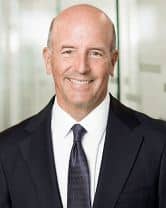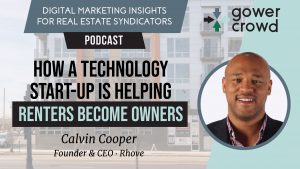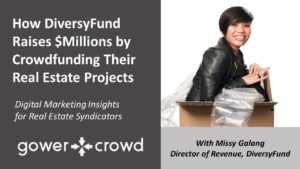FREE TRAINING
What is Real Estate Crowdfunding?
Learn how to build wealth and earn passive income in real estate while someone else does all the work.
222 Chuck Schreiber, CEO and Co-Founder, KBS

A $1 billion Fund for Accredited Investors without Up-front Fees*
Chuck Schreiber is a fifth generation Californian who grew up in Southern California. Loving mathematics he went to college to study finance and gravitated towards real estate and real estate investments because it was an investment opportunity where he saw opportunity to actively improve the performance of assets through their management rather than the passive activity of selecting stocks or other securities. He started his career in a brokerage company before forming a partnership with Don Koll, of Koll Development, and Peter Bren in 1991 that is today called KBS.

KBS recently launched the KBS Growth & Income Real Estate Fund, a first-of-its kind investment fund offered directly to accredited investors without up-front fees or commissions. The Fund is available for investment on KBSDirect.com. This fund presently has total equity acquisitions valued in excess of $179 million and distributed in strong U.S. markets.
Please join us as we chat with KBS CEO, Chuck Schreiber about his background in Real Estate and the opportunity that KBS is offering for accredited investors to participate in similar quality real estate investments offered to large pension funds and institutional investors.
Non-Performing Loans
In the first portfolio there were around 32 different loan investments that the banks called sub-performing but in actuality were non-performing. They were primarily construction loans that the bank had identified as bad assets that they needed to sell to free up liquidity. Chuck knew the loan officer who set up a data room and with about half a dozen different investors they went ahead and bought that portfolio.
That was in 1992 at a time when what had damaged the market so much was over-development primarily for commercial properties and this had led to considerable vacancy. It was very difficult to sell a building because buyers couldn't get loans. If you had a $20 million building you could not go to the bank and get even a $5 million loan. The banks were trying to rid themselves of assets that were categorized as bad assets or sub-performing assets and weren’t lending to buyers of similar types of assets.
The Savings and Loan crisis that hit at the end of the 1980’s could properly be described as a real estate depression. Property values started struggling in Texas and then it grew throughout the country. From a commercial standpoint it was much worse than the downturns in 2001, the so-called Tech Wreck, and worse even than the deep recession in 2008. In the early 1990’s you could not sell a building because no-one could get financing. The only buyers of buildings were all cash buyers and the volume of transactions just stopped.
Leaders of The Crowd
Conversations with Crowdfunding Visionaries and How Real Estate Stole the Show
Discover how laws that gave us crowdfunding were solely meant to finance small companies and yet inadvertently opened the doors to allow you to invest in real estate like never before.
Read the book and listen to the actual conversations.
Experience of Recession Informs KBS
KBS is extremely sensitive to risk. Even though the firm has a sizable portfolio they are a fairly nimble manager of real estate products and have a posture where they flee from risk. If they believe that something risky is going to happen in a marketplace or in a building or looking out two three four years they’ll go ahead and sell assets in that marketplace or sell a building if there is something they don’t like about it. Indeed, the company modified its investment strategy in 2010 to focus almost exclusively on Class A office buildings in central business districts. Up until that time their investment strategy was really focused on Class B properties where they would put cash into buildings, fix them up, make it a great location for businesses, lease them and then sell them. But what they realized in 2010 was that the only buildings that were leasing were the great Class A buildings. For example, they bought a building at that time in Chicago at 300 North LaSalle which was about 91 percent occupied. Built by Hines, it might have been one of the best buildings built in that decade.
During that time, the majority of assets in KBS’s portfolio weren’t getting traction on leasing activity and weren’t even having people look at buildings in these primarily Class B suburban office that they held. In a period of nine months they took 300 North LaSalle, which had over a million square feet, towards 98 percent leased. They had more leasing in that one building than they did in the balance of their whole portfolio. As a result, they modified their investment strategy to focus on Class A and to buy the best buildings they could in locations that they targeted as potential investment opportunities.
How to Fund Your Deals
7 Steps to Raising Equity Online
Class A Office Outperforms
The reason Class A outperforms other asset classes is that they are buildings that complement the principals who run the businesses in them. In 2009/2010 a couple of things happened. Number one, lease rates dropped in all products and what tenants realized was that they could sign a lease, move into a Class A building at the same lease rate they had been paying for a Class B building. Importantly, and in addition to this, what KBS also found is that principals of companies value their employees and their lifestyles much greater than they did a decade ago.
Buildings located in proximity to residences for employees have become an important driver for employers. To have a building which would be attractive for a young talented professional to work in that is close to a comfortable place to live really enhances their lifestyle. If they have an option to live in a great CBD whether it's San Francisco, or New York, or Los Angeles, Chicago, Portland, or some other great CBD, if they can walk to work or take public transportation to work or ride a bicycle to work it becomes just a great place to live and a great place for companies to locate and attract wonderful talent.
Recession Resilient
In earlier downturns there was a lot of discussion about large tenants moving out of the CBD and moving into suburban offices, but this is transitioning now because there are so many residential opportunities in, for example, downtown Chicago where people can simply walk to their office, or they can take a train and get out right downtown. There's so much residential development multifamily and condos and apartments just west of downtown Chicago that the downtown core has become increasingly accessible and attractive. Over the last 10 years there has been a substantial change downtown Chicago in the demand for office space.
And KBS is noticing this trend around the country. For example, markets such as Salt Lake City which institutional investors wouldn't even consider ten years or even five years ago as a primary market, now is a terrific market for investment. There are a couple of major tenants who've gone in and leased space of 140,000 square feet and then expanded for another 110,000 square feet in downtown Salt Lake City. It's become a wonderful market and KBS owns three buildings there that have been very successful because the two key changes there are the development of high quality residential downtown, and rapid transit bringing those who live outside of the CBD the ability to get to a job downtown.
KBS
One of the criteria that the fund applies when looking for core and core plus downtown assets is that there's been a revival in residential developments in the same area. A professional between the ages of 25 and 40 who's talented, who's educated, who has a great background; these folk want to live in proximity to where they work. They're not going to want to live out in a suburban area or even be in a situation where their office is out in a suburban area. Even if they only have a 10- or 15-minute drive to work, they don't want to get in their car to go get lunch. They want to go to the lobby in the building; they want to go out on the patio on the side of the building. They want to go across the street to the mall. They want to go across the street where there are restaurants, or maybe go shopping at lunchtime.
KBS bought a building in Portland Oregon, for example, and one of the most popular things they did was put 200 bike racks at the lower level of the building. Ten years ago, they wouldn't even have thought of such a thing.
Low Minimum
In 2005 KBS formed KBS Capital Advisors and entered into the non-traded REIT business focused on retail investors. By the third REIT of this kind, KBS REIT III, there was over $1.8 bn invested and yet the average was only $40,000 per investor. KBS is passionate about that because that $40,000 investment may be as important to that investor, to that couple, because this is retirement money for them. Chuck explains how he and his partners believe that is as important as a pension fund who's giving them an allocation of $200 million dollars.
The idea to go fully retail with KBS Direct started with their seventh fund, KBS Growth and Income. They raised over $70 million through a private placement and started to buy assets in 2016. At the time, they started looking at the availability of technology for the retail investor who would be able to educate themselves, or deal through a registered investment adviser, to make a decision to invest in a real estate product because KBS had the ability to offer some institutional grade real estate.
Today [at time of recording this podcast] the KBS Growth and Income Fund has a portfolio which is a little less in value than $200 million, with four different assets that are scattered around the country. The investment strategy is to buy top quality buildings in CBD markets and what they found was that through technology investors have been able to educate themselves on a variety of investment types. KBS believes that their transparency and ability to offer this kind of asset either directly to investors or through registered investment advisors with a no load and no commission profile is an attractive option for investors. One hundred percent of the money that an investor puts in goes right into the real estate and KBS believes that they are the only firm that has done this.
Putting something together like this is not easy because they had to write a number of checks to cover the upfront cost to create the structure, but they think it's going to be a unique opportunity. Investors have the ability to go through and look at the fee structure compared to other similar institutional caliber investment opportunities and really educate themselves on the fund, the potential risks, and the overall plan for the investment.
Yield
[As of time of podcast] KBS Growth and Income Fund is paying a five and a half percent dividend on a purchase price per share of $8.79. Annually, the fund establishes a new net asset value, a new value for the equity in the shares. At that time the share price will be adjusted to whatever the new net asset value is. The dividend is expected to be adjusted to roughly five and a half percent per year, paid monthly. Of course, dividend and period of the yield are not guaranteed and may change in the future.
Importantly, as a non-traded Fund, shareholders can't sell their shares. These are not investments for somebody who needs liquidity. Rather it is like an investment club. Think of it this way: It’s like if two or three people were going to buy a fourplex, or a small office building and hold for a period of time. There’s no liquidity, you would only be looking at yield and some long-term capital appreciation. KBS Growth and Income Fund is similar in this regard. Management anticipates having a hold period anywhere from a minimum of five years out to as much as 10 years. If people need this money for education, or for other needs during that 5- to 10-year period this is not the right investment for them.
KBS anticipates that the typical investor is going to be a $100 to $200 thousand investor who will look to be receiving 5.5 percent on that investment, per year, in cashflow coming back out to them. The firm also anticipates that there may be opportunities to grow the net asset value of the equity of the portfolio over the course of its life. It will be diversified throughout the country and the average size of the buildings the fund will acquire will be probably around $60 to $80 million because these are sizable institutional grade real estate projects.
While the intent of the fund is for longer term hold, they will go back during the hold period if there is a belief that there is an opportunity to realize returns, and may sell assets, reinvesting those dollars into other properties. That said, at a point some years out if KBS believes that is an appropriate time to sell the entire portfolio, they can return to investors and ask for their concurrence to liquidate. At that time, they decide whether to sell the portfolio to one buyer, whether that's an existing traded REIT or other institutional investor, or to sell the assets individually. It is expected that the fund will have maybe 15 to 20 different buildings in the portfolio and so, if it owns three buildings in Seattle for example, they may sell those buildings as a cluster to one buyer. However, in KBS’s history, they have typically sold buildings one at a time because they find it's a way to maximize returns for the investors because, while it takes more work to do that, they have found that they are able to negotiate higher prices.
Portfolio Liquidation
At the end of the fund’s lifetime, when management and the board believes that it's time to maximize return of the investor, they will go ahead and sell the entire portfolio. Perhaps there will be 15 assets, of which they might have sold 3 or 4 or 5 of them separately, but ultimately, they will target a 12-month period of time to go ahead and sell the balance of all remaining assets.
At the time when all assets are sold, the investors receive back their initial investment first, assuming sufficient funds available. Then, if the assets were bought right, there may be some equity growth, which would be a gain in addition to the cash flow that the fund will have been historically paying on a monthly basis. Of that excess gain, KBS receives a subordinated incentive fee of 15%, and the remainder is paid to investors. KBS is motivated to maximize returns to the investor, to provide above average returns to investors, because the firm then participates in any excess returns. If they do not generate that excess, then KBS just gets a flat fee, but they’re in business for, and are motivated by, the incentive fees.
Challenges Raising Money from The Crowd
One surprise that surfaced that was the first challenge when they sat down in 2016 and decided they were going to do this was cyber security. It was an area that was new to the firm and they consider themselves fortunate to surround themselves with two or three different professionals to help them go through this. If investors are going to be putting their name, address, their Social Security number into the online platform, that needs to be completely secured.
The other thing the KBS team found novel was that in their business they haven't historically done a lot of marketing presentations directly to investors. That's changed with KBSDirect and with related website communications. Being on a website, there is always the flexibility to change the message daily and to clarify terminology if need be.
That said, it is easy to just assume people may be very familiar with the terminology used. For example, a young lad approached Chuck, who had looked at the website which had stated that KBS is paying five and a half percent dividend, and his question was simply ‘is that good?’ Relative to a bank deposit interest rate, certainly, but how does that compare against other real estate investments?
A sophisticated real estate professional can be naive in thinking that everybody knows that 5.5 percent is a good solid return on a core asset in today’s market. KBS continually seeks ways to provide data to investors to help them understand how to compare one asset class against another and how prime downtown office building yield’s fit into the continuum.
One alternative, for example, is to invest in a traded REIT which is a very large business type, but their average dividend over the last year [at time of podcast] was somewhere below 4 percent. Now there are benefits because it is a liquid asset. If somebody wants to buy a hundred thousand shares that in six months later they want to liquidate, with a traded REIT they can sell those shares, and while it is possible to sell KBS Direct shares, it is discouraged because they would probably have to be sold at a discount.
Another term that is important to understand and perhaps little known, is the concept of load. The KBS Growth and Income Fund offering is a no-load product, and the website has been structured so that investors can research what this means without having to search around for explanations elsewhere. The information is right there as well as a team at the KBS offices who, should investors have any questions, are available to provide answers directly, by phone. This was another area where KBS stepped up and has built an infrastructure to be sure that they are really crystal clear with their communications.
Leverage
Traditionally KBS has not applied more than 50 percent leverage on assets and at their low end it is around 42 percent. On occasion, when they buy a building which they believe offers an opportunity to invest additional dollars for capital improvements, sometimes they will do that through debt. So an example might be that if they bought a $50 million dollar building and thought that the building should have, say, $3 million committed to a new lobby and elevators and parking, they might go to a lender and ask for a 50 percent loan to value, which would be $25 million loan, but then might record a loan in the building that's $28 million dollars. The remaining $3 million could be held in reserve and not funded at the acquisition, but as time goes on those funds could be used to improve the building. Ultimately this could mean a 56 percent loan to cost, but the objective would be to create value by putting in the extra $3 million, so the loan to value ratio would remain at or below 50 percent.
Flexibility
Having such levels of leverage also provides flexibility in the future should KBS want to go back and modify the loan. Whether they want to increase the loan amount or extend the term, there is much more flexibility because the lender throughout the entire hold period is an ally and extremely pleased to have the loan on their books.
Crowd Funding
Chuck thinks CFRE offers a wonderful opportunity although he shies away from the term ‘crowd’ funding for their offering as it suggests somebody who's going to invest a thousand dollars. It may be that in time KBS will market to those type of investors, but for now they are marketing exclusively to larger, accredited investors and registered investment advisors.
There are a handful of different organizations who are actively involved in providing opportunities for retail investors to invest in larger deals with smaller amounts of money. The key, Chuck says, is that investors take their time to research the website of the companies they are looking at investing in, to look at the track records and at the fee structures and to really get into the analysis. Crowd funding is a wonderful opportunity for investors because the alternative is to invest in a fourplex where, if a tenant moves out or two move out, all of a sudden you have 50 percent vacancy. Looking at institutional grade office buildings is just a different type of investment versus ‘retail’ real estate investing.
At KBS, Chuck notes, they are giving investors an opportunity to invest in properties that are comparable with the kinds of properties that CalPers or CalSTRS or New York Common or the State of Michigan Retirement System invests in; some of the best institutional real estate investors in the world invest in these types of assets. So why can't a $200,000-dollar investor be able to have that same opportunity or even a $10,000 investor. Now they too can do it because they can get the information online, they can get the data, and KBS is making it available.
RELATED PODCASTS
371 Calvin Cooper, Co-founder and CEO, Rhove
Last Updated on September 15, 2021 by Dr. Adam Gower Calvin Cooper, Rhove How a Technology Startup is Helping Renters Become Owners The Investor Acquisition System: Find More Investors Raise…
READ MORE >324 Missy Galang, Director of Revenue, Diversyfund
Last Updated on June 22, 2020 by Dr. Adam Gower WHITE BOARD WORKSHOP Need More Money to Finance Your Real Estate Projects? Learn how to find more investors, raise more…
READ MORE >336 Judy Brower Fancher, The Brower Group
Last Updated on September 15, 2021 by Dr. Adam Gower WHITE BOARD WORKSHOP Need More Money to Finance Your Real Estate Projects? Learn how to find more investors, raise more…
READ MORE >












